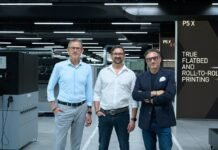Print and pre-press processes have long benefited from all the advantages that ‘digital’ affords, but the digitalization of post-press or finishing is still in its infancy. Here, Juergen Freier looks at the continued evolution of digital finishing in an ever-evolving packaging landscape.

Photo Highcon
Digitalization is not a new term. Indeed digital printing had its breakthrough some decades ago – and since then, it has been embraced as a mainstream printing technology. But, to deliver the true value that a digital process can offer and that it has long promised, we need to assess what happens after the printing phase and where the finishing bottlenecks lie. This is surely the next digital transformation, with an increased need to meet tight deadlines and be more sustainable, driving this trend further.
For over a hundred years, the industry has utilized conventional die-cutting technology for high-quality cutting and creasing services. But, like many analogue processes, die-cutting is both labour and substrate intensive, making it an expensive and environmentally challenging process. As a result, converters are either proactively looking for or are under pressure from customers to find an alternative digital solution. Converting materials without the use of dies is an obvious alternative. It enables cost-effective production of any run-length, meeting and in some cases exceeding the vast capabilities of conventional finishing processes.
On digital converting systems, Highcon’s specifically, cutting and creasing are separated – meaning, there is no restriction on cutting or creasing. Nicks are fully editable, so changes can be made even at the last minute – achieving the optimal balance between the ease of blanking and the integrity of the sheet. To improve gluing and reduce complexities, lasers can also be used to etch surface flaps on the laminated or varnished stock. Add the capabilities of variable data cutting and online editing capabilities, and we start to move into the realms of a true end-to-end digital workflow.
McGowans Digital Print, a longstanding advocate for digital print and finishing, is a great recent example. It’s the first print house to install a digital converting system in Ireland, working alongside a B1 Landa press. Used to expand into new and profitable packaging markets, McGowans expects a 30% increase in revenue from its new Highcon Beam 2 digital cutting and creasing solution and Landa press. Mal McGowan, McGowans, managing director, comments, “Benny Landa had a quote, ‘everything that can be digital will be digital, and print is no different’ – and finishing fits that mould. Thanks to Highcon and as part of a truly digital future, we have been able to digitize cutting and scoring within our business. This has allowed us to compete in new and emerging markets while offering new benefits to existing customers. Digital finishing has also enabled the launch of our all-new on-demand e-commerce site, BoxJob.com.”
And McGowan’s Digital Print is not alone. Converters worldwide are adopting digital cutting and creasing system capabilities to reduce lead times, eliminate backlogs and improve the overall supply chain. In this new pandemic era, boxes are in even higher demand. Brands require increased flexibility from suppliers and their folding carton and corrugated packaging services, which has further accelerated the adoption of digital manufacturing technologies to support it.
The web-to-pack (carton and corrugated) production line business model is a great fit for enabling this market change. Many successful converters are starting to run both conventional and digital manufacturing processes in parallel.
At Highcon, our vision is for a fully implemented digital manufacturing strategy. This extends beyond the digital finishing solution to other areas where automation is key to unlocking new levels of workflow efficiencies for increased business success. For example, Highcon recently announced a strategic partnership with Tilia Labs to see tilia Phoenix, its flagship planning and imposition application, provided with every Highcon system going forward. It employs Artificial Intelligence (AI) technology to enable optimal imposition and dynamic job ganging on a single sheet. This solution reduces the overall number of set-ups and ensures a healthy set-up: production time ratio, helping to achieve optimum productivity with minimal waste.
With the right digital vendors, technology and workflow set-up, converters can maximize production efficiencies from their finishing process. And this enables them to run more jobs per shift, offer shorter run lengths, add value by driving personalization, significantly reduce waste and increase profitability.
The foundations laid, and though in early days, the digitalization of post-press and finishing is happening – and it’s happening now. The technology proves itself as a total game-changer for many converters and brands alike. Successful converters will take full advantage of digital capabilities to create real-time supply chains to synchronize supply and demand. Finishing is the final frontier for true digitalization of the packaging process, and we’re excited to be a part of it.












